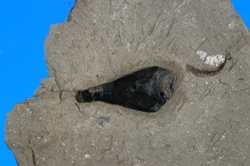In 160 million years there hasn’t been any change in the chemistry of squid ink - living proof that natural selection is conservative. Ted Nield reports.
 Geoscientist 22.06 July 2012
Geoscientist 22.06 July 2012
Picture: The ink sac from a 160Ma giant cephalopod fossil contains melanin; essentially identical to melanin found in the modern cuttlefish. (Credit: Image courtesy of University of Virginia)
We tend to associate the term 'natural selection' with evolution and therefore 'change'; but the fact is that if things don’t need to change, they need to stay the same – and under constant conditions, natural selection makes sure that they do. An international team of researchers has found that two ink sacs from 160-million-year-old giant cephalopod fossils, discovered two years ago by Phillip Wilby of the British Geological Survey in Christian Malford, Wiltshire, contain the pigment melanin that is chemically identical to that found in the modern cuttlefish. This extremely rare example of organic material being preserved intact for hundreds of millions of years suggests that the ink-screen escape mechanism employed by cephalopods has not changed in all that time.
"Though the other organic components of the cephalopod we studied are long gone, we've discovered through a variety of research methods that the melanin has remained in a condition that could be studied in exquisite detail," said Professor John Simon, one of the study authors, at the University of Virginia.
One of the ink sacs studied was the only intact ink-sac ever found. Wilby sent samples to Simon and to Japanese chemist Shoskue Ito, both melanin experts. They then engaged research colleagues in the USA, UK, Japan and India to investigate the samples using a combination of direct, high-resolution chemical techniques to determine whether or not the melanin had been preserved. They then compared the chemical composition of the fossil melanin to that of the common cuttlefish, Sepia officinalis.
Simon told reporters: "It's close enough that I would argue that the pigmentation in this class of animals has not evolved in 160 million years," Simon said. "The whole machinery apparently has been locked in time and passed down through succeeding generations of cuttlefish. It's a very optimised system for this animal and has been optimised for a long time."
The melanin molecule is extremely resistant, Simon explains. "Out of all of the organic pigments in living systems, melanin has the highest odds of being found in the fossil record" he says. "That attribute also makes it a challenge to study. We had to use innovative methods from chemistry, biology and physics to isolate the melanin from the inorganic material."
The researchers cross-checked their work using complementary experiments designed to capitalise on various molecular features unique to melanin, and determined its molecular morphology and chemical composition. This combination of in-depth, multidisciplinary techniques is not normally used by paleontologists to study fossil samples.
"I think the strength of this paper is that it is not tied to a single method" Simon told Geoscientist. "Any one technique would have brought some insights, but potentially more questions than insights. It was really the more holistic approach that fully characterised it and allowed us to actually do a real comparison between what existed during the Jurassic period and what exists now.
"It's also given us a handle on ways of identifying organic components in fossils that might have been missed using standard methods."
Reference
- Keely Glass, Shosuke Ito, Philip R Wilby, Takayuki Sota, Atsushi Nakamura, C Russell Bowers, Jakob Vinther, Suryendu Dutta, Roger Summons, Derek E G Briggs, Kazumasa Wakamatsu, and John D Simon. Direct chemical evidence for eumelanin pigment from the Jurassic period. PNAS, May 21, 2012 DOI: 10.1073/pnas.1118448109